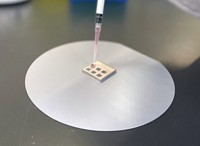Advertisement
Grab your lab coat. Let's get started
Welcome!
Welcome!
Create an account below to get 6 C&EN articles per month, receive newsletters and more - all free.
It seems this is your first time logging in online. Please enter the following information to continue.
As an ACS member you automatically get access to this site. All we need is few more details to create your reading experience.
Not you? Sign in with a different account.
Not you? Sign in with a different account.
ERROR 1
ERROR 1
ERROR 2
ERROR 2
ERROR 2
ERROR 2
ERROR 2
Password and Confirm password must match.
If you have an ACS member number, please enter it here so we can link this account to your membership. (optional)
ERROR 2
ACS values your privacy. By submitting your information, you are gaining access to C&EN and subscribing to our weekly newsletter. We use the information you provide to make your reading experience better, and we will never sell your data to third party members.
Biological Chemistry
Nanotech-based Sensors
Forewarned Is Forearmed
by SOPHIE L. ROVNER, C&EN WASHINGTON
February 21, 2005
| A version of this story appeared in
Volume 83, Issue 8

The only sure way to confirm a diagnosis of Alzheimer's disease is to conduct an autopsy. Naturally, physicians would prefer to have a tool that could definitively evaluate living patients. Even better, the device should provide an early warning that an individual is at risk for getting the disease. Two new assays that apply nanotechnology-based methods recently developed at Northwestern University may fill the bill.

The assays can be used to test cerebrospinal fluid for the presence of amyloid- β-derived diffusible ligands (ADDLs). These small, soluble oligomers of amyloid-β are suspected of contributing to the development of Alzheimer's. More important, they are thought to show up long before disease symptoms appear. If physicians could detect ADDLs early enough, they might be able to intervene and prevent the disease from taking hold. Such detection has not been possible before because the concentration of ADDLs in cerebrospinal fluid is so low--on the order of 1 picomolar or less. Now, chemistry professor Richard P. Van Duyne, neurobiology professor William L. Klein, and colleagues have designed a sensor sensitive enough to detect ADDLs and study their behavior at physiologically relevant concentrations [J. Am. Chem. Soc., 127, 2264 (2005)]. At present, the assay can detect ADDLs at a concentration down to about 50 femtomolar. Van Duyne notes that it could also be used to screen for drugs that can block ADDL formation. The sensor uses his localized surface plasmon resonance spectroscopy technique (C&EN, Aug. 19, 2002, page 10).
Chemistry professor Chad A. Mirkin, also collaborating with Klein, headed a group that had earlier created an even more sensitive ADDL sensor [Proc. Natl. Acad. Sci. USA, 102, 2273 (2005)]. The sensor, with a minimum ADDL detection limit around 100 attomolar, is based on Mirkin's "bio-bar code" assay (C&EN, May 10, 2004, page 37). Mirkin believes the technology could be used in probes for many other biological disease markers that currently "go under the radar of conventional diagnostic tools" because of their low biological concentrations.
MORE ON THIS STORY




Join the conversation
Contact the reporter
Submit a Letter to the Editor for publication
Engage with us on Twitter